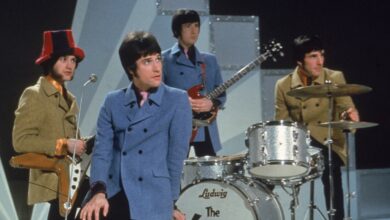Suite: Judy Blue Eyes – The Timeless Masterpiece That Defined Crosby, Stills & Nash’s Harmonious Legacy
In the tapestry of 1960s rock music, few compositions stand as intricate and emotionally resonant as “Suite: Judy Blue Eyes” by Crosby, Stills & Nash (CSN). Released in 1969, this multipart suite not only showcased the trio’s harmonious synergy but also encapsulated the personal turmoils and artistic ambitions that defined their early collaboration.
The genesis of CSN is a story of serendipitous convergence. David Crosby, formerly of The Byrds; Stephen Stills, a key figure in Buffalo Springfield; and Graham Nash from The Hollies found themselves at a crossroads in the late 1960s. Each had departed from their respective bands, seeking new creative avenues. Their paths intertwined in the vibrant music scene of Laurel Canyon, Los Angeles, where a casual jam session revealed an extraordinary vocal chemistry. This impromptu harmony laid the foundation for what would become one of rock’s most iconic supergroups.
“Suite: Judy Blue Eyes” emerged from a deeply personal space. Stephen Stills penned the song as a heartfelt reflection on his impending breakup with singer-songwriter Judy Collins. The title itself is a play on words, combining “suite” (a series of musical pieces) with “sweet,” and directly referencing Collins’ striking blue eyes. Stills’ emotional turmoil is woven throughout the song’s lyrics, capturing the bittersweet essence of love and loss.
Structurally, the song is a marvel. Spanning over seven minutes, it comprises four distinct sections, each transitioning seamlessly into the next. This suite-like composition was unconventional for its time, especially in the rock genre, and it showcased the trio’s willingness to push musical boundaries. The intricate harmonies, combined with Stills’ adept guitar work, created a rich tapestry of sound that captivated listeners.
The opening segment sets a reflective tone, with Stills’ plaintive vocals expressing a yearning to “open up the door.” As the piece progresses, it shifts through various moods and tempos, reflecting the tumultuous emotions associated with a fading relationship. The final section, sung in Spanish, adds a layer of mystique and cultural depth, leaving audiences both intrigued and moved.
Upon its release on CSN’s self-titled debut album in May 1969, “Suite: Judy Blue Eyes” quickly became a standout track. The album itself was a commercial success, peaking at number six on the Billboard album chart and remaining there for an impressive 107 weeks. The song was also released as a single, reaching number 21 on the Billboard Hot 100. Its success was a testament to the trio’s harmonious blend and the song’s intricate composition.
The impact of “Suite: Judy Blue Eyes” extended beyond commercial metrics. It became emblematic of the era’s countercultural movement, resonating with a generation seeking authenticity and emotional depth in music. The song’s complex structure and heartfelt lyrics stood in contrast to the more straightforward pop tunes of the time, offering listeners a richer, more immersive experience.
A defining moment for CSN came with their performance at the Woodstock Festival in August 1969. “Suite: Judy Blue Eyes” was part of their setlist, and their live rendition further cemented the song’s legendary status. The trio’s harmonious vocals and Stills’ masterful guitar work captivated the massive audience, marking their first major public performance and solidifying their place in rock history.
The song’s influence reverberated through the music industry, inspiring artists to explore more complex compositions and personal storytelling. Its success demonstrated that audiences were receptive to longer, more intricate songs, paving the way for future progressive rock and concept albums. The fusion of folk, rock, and intricate harmonies in “Suite: Judy Blue Eyes” became a blueprint for many artists in the ensuing decades.
In the years following its release, “Suite: Judy Blue Eyes” remained a staple in CSN’s live performances. Its enduring appeal lies in its emotional honesty and musical complexity, qualities that continue to resonate with audiences today. The song’s legacy is evident in its frequent inclusion in “greatest songs” lists and its influence on subsequent generations of musicians.
Reflecting on the song’s creation, Stephen Stills acknowledged the raw emotion that fueled its composition. In interviews, he has spoken about the cathartic process of writing the song and its role in helping him navigate the end of his relationship with Judy Collins. This personal connection adds a layer of authenticity that listeners can feel, even decades later.
The collaborative dynamic of Crosby, Stills, and Nash was crucial to the song’s development. Each member brought their unique strengths to the table: Crosby’s innovative harmonies, Stills’ instrumental prowess, and Nash’s melodic sensibilities. This synergy is palpable in “Suite: Judy Blue Eyes,” where their talents converge to create a piece that is greater than the sum of its parts.
Over time, the song has been covered by various artists, each bringing their own interpretation while honoring the original’s complexity and emotion. These renditions are a testament to the song’s versatility and enduring relevance. Its themes of love, loss, and introspection are universal, allowing it to transcend its original context and continue to touch listeners across generations.
In the broader scope of CSN’s career, “Suite: Judy Blue Eyes” stands as a defining achievement. It encapsulates the essence of their collaboration and serves as a benchmark for their subsequent work. The song’s success helped establish them as a formidable force in the music industry and set the stage for future projects, both as a trio and in their various solo endeavors.
Today, “Suite: Judy Blue Eyes” remains a beloved classic, celebrated for its artistic ambition and emotional depth. Its place in music history is well-deserved, and its influence continues to be felt. For both longtime fans and new listeners, the song offers a rich, rewarding experience that exemplifies the transformative power of music.



